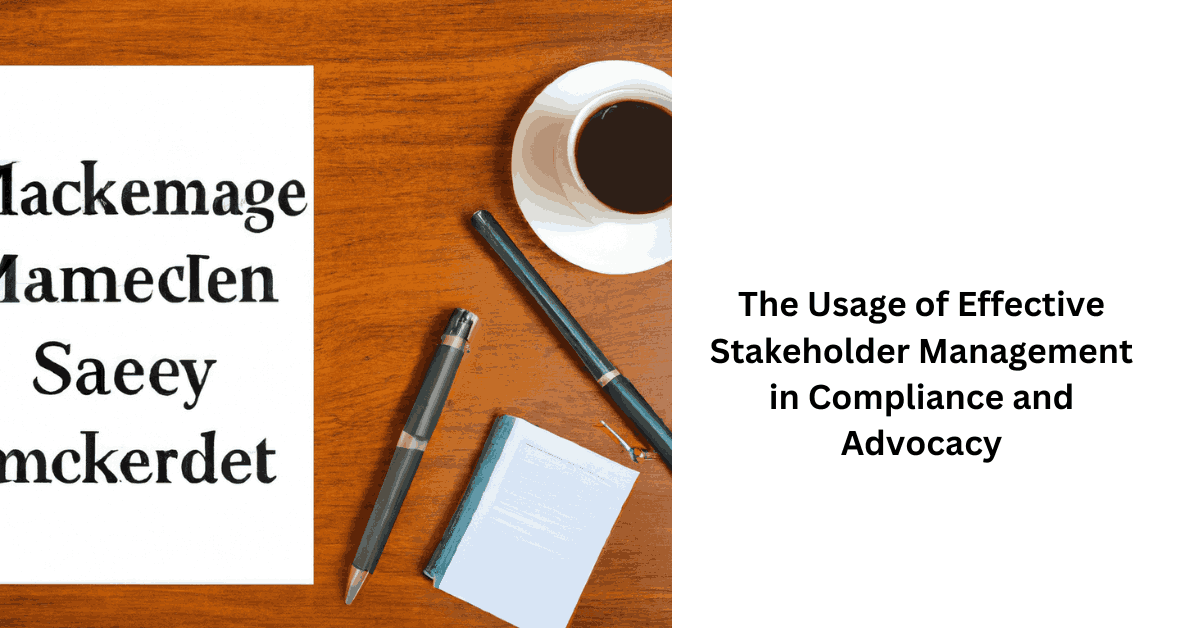The Usage of Effective Stakeholder Management in Compliance and Advocacy

In the intricate landscape of government affairs, engaging with regulatory bodies stands as a pivotal aspect of stakeholder management. Regulatory bodies wield significant influence, shaping policies, enforcing compliance, and playing a critical role in the regulatory framework that governs industries.
This article explores the nuances of effectively managing stakeholders when engaging with regulatory bodies, balancing the imperatives of compliance and advocacy for the benefit of organizations and society at large.
Understanding the Regulatory Landscape
Before delving into stakeholder management, it’s essential for organizations to have a comprehensive understanding of the regulatory landscape. This includes identifying relevant regulatory bodies, understanding their mandates, and staying informed about the regulatory frameworks that impact the industry.
Stakeholder Mapping for Regulatory Engagement
Stakeholder mapping is a crucial step in regulatory engagement. Organizations must identify and categorize stakeholders within regulatory bodies, including key decision-makers, influencers, and subject matter experts. This mapping informs targeted engagement strategies tailored to the specific needs and concerns of regulatory stakeholders.
Compliance as a Foundation
Compliance with regulations is the bedrock of engaging with regulatory bodies. Organizations must prioritize adherence to applicable laws and standards, recognizing that compliance not only ensures legal standing but also fosters a positive relationship with regulatory stakeholders.
Proactive Communication with Regulatory Stakeholders
Effective stakeholder management involves proactive communication. Organizations should establish open lines of communication with regulatory bodies, providing timely updates on industry developments, seeking clarification on regulations, and actively participating in dialogue to address emerging challenges.
Collaborative Approaches to Compliance
Rather than viewing compliance as a burdensome obligation, organizations can adopt a collaborative approach. Engaging with regulatory bodies collaboratively involves seeking feedback, providing insights, and actively participating in the regulatory process. This approach positions organizations as partners in achieving regulatory objectives.
Advocacy within Regulatory Boundaries
While compliance is paramount, organizations can engage in advocacy within the boundaries of regulations. This involves articulating industry perspectives, providing evidence-based arguments, and advocating for regulatory approaches that balance industry growth with societal well-being.
Building Relationships Beyond Compliance
Effective stakeholder management extends beyond the confines of compliance. Building relationships with regulatory stakeholders involves understanding their perspectives, attending regulatory meetings, and actively participating in industry forums. These efforts contribute to a more nuanced understanding and collaborative engagement.
Transparency in Regulatory Dealings
Transparency is a cornerstone of positive stakeholder management in regulatory affairs. Organizations should be transparent in their dealings with regulatory bodies, providing accurate information, disclosing potential challenges, and actively participating in public consultations to contribute to transparent decision-making processes.
Establishing a Regulatory Affairs Team
Organizations can enhance their stakeholder management efforts by establishing a dedicated regulatory affairs team. This team serves as a liaison between the organization and regulatory bodies, ensuring a focused approach to compliance, advocacy, and ongoing communication.
Continuous Monitoring and Adaptation
The regulatory landscape is dynamic, subject to changes in laws, policies, and societal expectations. Effective stakeholder management involves continuous monitoring of regulatory developments and adapting strategies accordingly. This proactive approach ensures that organizations remain agile and responsive to evolving regulatory landscapes.
Stakeholder Education on Regulatory Matters
Educating internal and external stakeholders on regulatory matters is a proactive stakeholder management strategy. By fostering a deep understanding of regulatory requirements and implications, organizations empower stakeholders to actively contribute to compliance efforts and advocate for industry positions.
Addressing Regulatory Challenges Head-On
Challenges in regulatory affairs are inevitable, ranging from changing regulations to unforeseen compliance issues. Effective stakeholder management involves addressing challenges head-on, demonstrating a commitment to rectifying issues, and collaborating with regulatory bodies to find mutually beneficial solutions.
Leveraging Technology for Regulatory Compliance
In the digital age, technology can be a powerful ally in regulatory affairs. Organizations can leverage regulatory compliance software, data analytics, and digital platforms to streamline compliance processes, enhance reporting capabilities, and ensure efficient engagement with regulatory stakeholders.
Engaging in Social Responsibility Initiatives
Organizations can go beyond the minimum compliance requirements by actively engaging in social responsibility initiatives. Demonstrating a commitment to societal well-being and environmental stewardship contributes positively to the organization’s image and fosters goodwill with regulatory stakeholders.
The Role of Legal Counsel in Stakeholder Engagement
Legal counsel plays a crucial role in stakeholder management within regulatory affairs. Engaging legal experts ensures that organizations navigate the complex legal landscape of government affairs, interpret regulations accurately, and address legal aspects of compliance and advocacy with precision.
Conclusion
Effectively engaging with regulatory bodies requires a strategic and holistic approach to stakeholder management. By prioritizing compliance, embracing proactive communication, and advocating for industry interests within the bounds of regulations, organizations can navigate the regulatory seas with confidence.
The synergy between compliance and advocacy, coupled with transparent and collaborative stakeholder engagement, positions organizations as responsible contributors to regulatory frameworks, fostering a harmonious relationship between industry and regulatory bodies.

